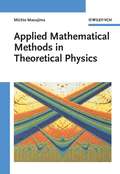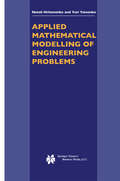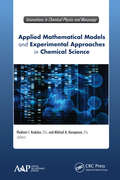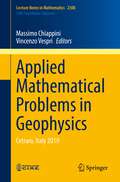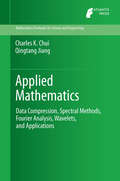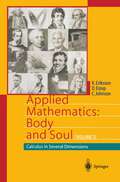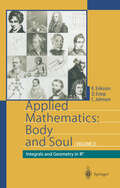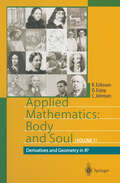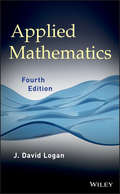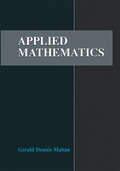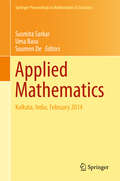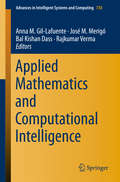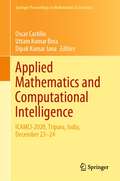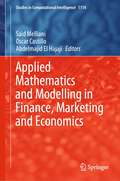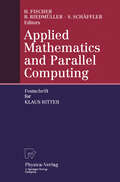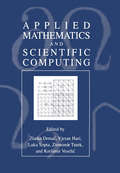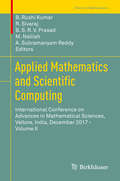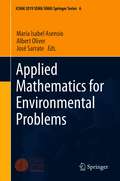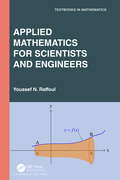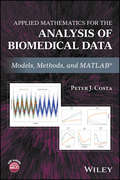- Table View
- List View
Applied Mathematical Methods in Theoretical Physics
by Michio MasujimaAll there is to know about functional analysis, integral equations and calculus of variations in a single volume. This advanced textbook is divided into two parts: The first on integral equations and the second on the calculus of variations. It begins with a short introduction to functional analysis, including a short review of complex analysis, before continuing a systematic discussion of different types of equations, such as Volterra integral equations, singular integral equations of Cauchy type, integral equations of the Fredholm type, with a special emphasis on Wiener-Hopf integral equations and Wiener-Hopf sum equations. After a few remarks on the historical development, the second part starts with an introduction to the calculus of variations and the relationship between integral equations and applications of the calculus of variations. It further covers applications of the calculus of variations developed in the second half of the 20th century in the fields of quantum mechanics, quantum statistical mechanics and quantum field theory. Throughout the book, the author presents over 150 problems and exercises - many from such branches of physics as quantum mechanics, quantum statistical mechanics, and quantum field theory - together with outlines of the solutions in each case. Detailed solutions are given, supplementing the materials discussed in the main text, allowing problems to be solved making direct use of the method illustrated. The original references are given for difficult problems. The result is complete coverage of the mathematical tools and techniques used by physicists and applied mathematicians Intended for senior undergraduates and first-year graduates in science and engineering, this is equally useful as a reference and self-study guide.
Applied Mathematical Modelling of Engineering Problems (Applied Optimization #81)
by N.V. Hritonenko Yuri P. YatsenkoThe subject of the book is the "know-how" of applied mathematical modelling: how to construct specific models and adjust them to a new engineering environment or more precise realistic assumptions; how to analyze models for the purpose of investigating real life phenomena; and how the models can extend our knowledge about a specific engineering process. Two major sources of the book are the stock of classic models and the authors' wide experience in the field. The book provides a theoretical background to guide the development of practical models and their investigation. It considers general modelling techniques, explains basic underlying physical laws and shows how to transform them into a set of mathematical equations. The emphasis is placed on common features of the modelling process in various applications as well as on complications and generalizations of models. The book covers a variety of applications: mechanical, acoustical, physical and electrical, water transportation and contamination processes; bioengineering and population control; production systems and technical equipment renovation. Mathematical tools include partial and ordinary differential equations, difference and integral equations, the calculus of variations, optimal control, bifurcation methods, and related subjects.
Applied Mathematical Models and Experimental Approaches in Chemical Science (Innovations in Chemical Physics and Mesoscopy)
by Vladimir I. Kodolov DSc Mikhail A. KorepanovThis new book focuses on nanomaterial development as well as investigations of combustion and explosion processes. It presents valuable information on the modeling of processes and on quantum chemical calculations and leading-edge research from around the world in this dynamic field, focusing on concepts above formal experimental techniques and theoretical methods of chemical physics for micro- and nanotechnologies. Also presented are non-linear kinetic appearances and their possible applications.
Applied Mathematical Models and Experimental Approaches in Chemical Science (Innovations in Chemical Physics and Mesoscopy)
by Vladimir Ivanovitch Kodolov Mikhail A. KorepanovThis new book focuses on nanomaterial development as well as investigations of combustion and explosion processes. It presents valuable information on the modeling of processes and on quantum chemical calculations and leading-edge research from around the world in this dynamic field, focusing on concepts above formal experimental techniques and theoretical methods of chemical physics for micro- and nanotechnologies. Also presented are non-linear kinetic appearances and their possible applications.
Applied Mathematical Problems in Geophysics: Cetraro, Italy 2019 (Lecture Notes in Mathematics #2308)
by Massimo Chiappini Vincenzo VespriThis CIME Series book provides mathematical and simulation tools to help resolve environmental hazard and security-related issues.The contributions reflect five major topics identified by the SIES (Strategic Initiatives for the Environment and Security) as having significant societal impact: optimal control in waste management, in particular the degradation of organic waste by an aerobic biomass, by means of a mathematical model; recent developments in the mathematical analysis of subwave resonators; conservation laws in continuum mechanics, including an elaboration on the notion of weak solutions and issues related to entropy criteria; the applications of variational methods to 1-dimensional boundary value problems, in particular to light ray-tracing in ionospheric physics; and the mathematical modelling of potential electromagnetic co-seismic events associated to large earthquakes.This material will provide a sound foundation for those who intend to approach similar problems from a multidisciplinary perspective.
Applied Mathematics: Data Compression, Spectral Methods, Fourier Analysis, Wavelets, and Applications (Mathematics Textbooks for Science and Engineering #2)
by Charles K. Chui Qingtang JiangThis textbook, apart from introducing the basic aspects of applied mathematics, focuses on recent topics such as information data manipulation, information coding, data approximation, data dimensionality reduction, data compression, time-frequency and time scale bases, image manipulation, and image noise removal. The methods treated in more detail include spectral representation and “frequency” of the data, providing valuable information for, e.g. data compression and noise removal. Furthermore, a special emphasis is also put on the concept of “wavelets” in connection with the “multi-scale” structure of data-sets. The presentation of the book is elementary and easily accessible, requiring only some knowledge of elementary linear algebra and calculus. All important concepts are illustrated with examples, and each section contains between 10 an 25 exercises. A teaching guide, depending on the level and discipline of instructions is included for classroom teaching and self-study.
Applied Mathematics: Calculus in Several Dimensions
by Kenneth Eriksson Donald Estep Claes JohnsonApplied Mathematics: Body & Soul is a mathematics education reform project developed at Chalmers University of Technology and includes a series of volumes and software. The program is motivated by the computer revolution opening new possibilitites of computational mathematical modeling in mathematics, science and engineering. It consists of a synthesis of Mathematical Analysis (Soul), Numerical Computation (Body) and Application. Volumes I-III present a modern version of Calculus and Linear Algebra, including constructive/numerical techniques and applications intended for undergraduate programs in engineering and science. Further volumes present topics such as Dynamical Systems, Fluid Dynamics, Solid Mechanics and Electro-Magnetics on an advanced undergraduate/graduate level. The authors are leading researchers in Computational Mathematics who have written various successful books.
Applied Mathematics: Volume 2: Integrals and Geometry in IRn
by Kenneth Eriksson Donald Estep Claes JohnsonApplied Mathematics: Body & Soul is a mathematics education reform project developed at Chalmers University of Technology and includes a series of volumes and software. The program is motivated by the computer revolution opening new possibilities of computational mathematical modeling in mathematics, science and engineering. It consists of a synthesis of Mathematical Analysis (Soul), Numerical Computation (Body) and Application. Volumes I-III present a modern version of Calculus and Linear Algebra, including constructive/numerical techniques and applications intended for undergraduate programs in engineering and science. Further volumes present topics such as Dynamical Systems, Fluid Dynamics, Solid Mechanics and Electro-Magnetics on an advanced undergraduate/graduate level. The authors are leading researchers in Computational Mathematics who have written various successful books.
Applied Mathematics: Volume 1: Derivatives and Geometry in IR3
by Kenneth Eriksson Donald Estep Claes JohnsonApplied Mathematics: Body & Soul is a mathematics education reform project developed at Chalmers University of Technology and includes a series of volumes and software. The program is motivated by the computer revolution opening new possibilitites of computational mathematical modeling in mathematics, science and engineering. It consists of a synthesis of Mathematical Analysis (Soul), Numerical Computation (Body) and Application. Volumes I-III present a modern version of Calculus and Linear Algebra, including constructive/numerical techniques and applications intended for undergraduate programs in engineering and science. Further volumes present topics such as Dynamical Systems, Fluid Dynamics, Solid Mechanics and Electro-Magnetics on an advanced undergraduate/graduate level. The authors are leading researchers in Computational Mathematics who have written various successful books.
Applied Mathematics (Undergraduate Texts in Mathematics)
by J. David LoganPraise for the Third Edition “Future mathematicians, scientists, and engineers should find the book to be an excellent introductory text for coursework or self-study as well as worth its shelf space for reference.” —MAA Reviews Applied Mathematics, Fourth Edition is a thoroughly updated and revised edition on the applications of modeling and analyzing natural, social, and technological processes. The book covers a wide range of key topics in mathematical methods and modeling and highlights the connections between mathematics and the applied and natural sciences. The Fourth Edition covers both standard and modern topics, including scaling and dimensional analysis; regular and singular perturbation; calculus of variations; Green’s functions and integral equations; nonlinear wave propagation; and stability and bifurcation. The book provides extended coverage of mathematical biology, including biochemical kinetics, epidemiology, viral dynamics, and parasitic disease. In addition, the new edition features: Expanded coverage on orthogonality, boundary value problems, and distributions, all of which are motivated by solvability and eigenvalue problems in elementary linear algebra Additional MATLAB® applications for computer algebra system calculations Over 300 exercises and 100 illustrations that demonstrate important concepts New examples of dimensional analysis and scaling along with new tables of dimensions and units for easy reference Review material, theory, and examples of ordinary differential equations New material on applications to quantum mechanics, chemical kinetics, and modeling diseases and viruses Written at an accessible level for readers in a wide range of scientific fields, Applied Mathematics, Fourth Edition is an ideal text for introducing modern and advanced techniques of applied mathematics to upper-undergraduate and graduate-level students in mathematics, science, and engineering. The book is also a valuable reference for engineers and scientists in government and industry.
Applied Mathematics
by Gerald D. MahanThis volume is a textbook for a year-long graduate level course in All research universities have applied mathematics for scientists and engineers. such a course, which could be taught in different departments, such as mathematics, physics, or engineering. I volunteered to teach this course when I realized that my own research students did not learn much in this course at my university. Then I learned that the available textbooks were too introduc tory. While teaching this course without an assigned text, I wrote up my lecture notes and gave them to the students. This textbook is a result of that endeavor. When I took this course many, many, years ago, the primary references were the two volumes of P. M. Morse and H. Feshbach, Methods of Theoretical Physics (McGraw-Hill, 1953). The present text returns the contents to a similar level, although the syllabus is quite different than given in this venerable pair of books.
Applied Mathematics: Kolkata, India, February 2014 (Springer Proceedings in Mathematics & Statistics #146)
by Susmita Sarkar Uma Basu Soumen DeThe book is based on research presentations at the international conference, “Emerging Trends in Applied Mathematics: In the Memory of Sir Asutosh Mookerjee, S.N. Bose, M.N. Saha and N.R. Sen”, held at the Department of Applied Mathematics, University of Calcutta, during 12–14 February 2014. It focuses on various emerging and challenging topics in the field of applied mathematics and theoretical physics. The book will be a valuable resource for postgraduate students at higher levels and researchers in applied mathematics and theoretical physics.Researchers presented a wide variety of themes in applied mathematics and theoretical physics—such as emergent periodicity in a field of chaos; Ricci flow equation and Poincare conjecture; Bose–Einstein condensation; geometry of local scale invariance and turbulence; statistical mechanics of human resource allocation: mathematical modelling of job-matching in labour markets; contact problem in elasticity; the Saha equation; computational fluid dynamics with applications in aerospace problems; an introduction to data assimilation, stochastic analysis and bounds on noise for Holling type-II model, graph theoretical invariants of chemical and biological systems; strongly correlated phases and quantum phase transitions of ultra cold bosons; and the mathematical modelling of breast cancer treatment.
Applied Mathematics and Computational Intelligence (Advances in Intelligent Systems and Computing #730)
by Anna M. Gil-Lafuente José M. Merigó Bal Kishan Dass Rajkumar VermaThis book gathers selected papers presented at the conference of the Forum for Interdisciplinary Mathematics (FIM), held at Palau Macaya, Barcelona, on 18 to 20 November, 2015. The event was co-organized by the University of Barcelona (Spain), the Spanish Royal Academy of Economic and Financial Sciences (Spain) and the Forum for Interdisciplinary Mathematics (India). This instalment of the conference was presented with the title “Applied Mathematics and Computational Intelligence” and particularly focused on the use of Mathematics and Computational Intelligence techniques in a diverse range of scientific disciplines, as well as their applications in real-world problems. The book presents thirty peer-reviewed research papers, organised into four topical sections: on Mathematical Foundations; Computational Intelligence and Optimization Techniques; Modelling and Simulation Techniques; and Applications in Business and Engineering. This book will be of great interest to anyone working in the area of applied mathematics and computational intelligence and will be especially useful for scientists and graduate students pursuing research in these fields.
Applied Mathematics and Computational Intelligence: ICAMCI-2020, Tripura, India, December 23–24 (Springer Proceedings in Mathematics & Statistics #413)
by Oscar Castillo Uttam Kumar Bera Dipak Kumar JanaThis book contains select papers presented at the International Conference on Applied Mathematics and Computational Intelligence (ICAMCI-2020), held at the National Institute of Technology Agartala, Tripura, India, from 19–20 March 2020. It discusses the most recent breakthroughs in intelligent techniques such as fuzzy logic, neural networks, optimization algorithms, and their application in the development of intelligent information systems by using applied mathematics. The book also explains how these systems will be used in domains such as intelligent control and robotics, pattern recognition, medical diagnosis, time series prediction, and complicated problems in optimization. The book publishes new developments and advances in various areas of type-3 fuzzy, intuitionistic fuzzy, computational mathematics, block chain, creak analysis, supply chain, soft computing, fuzzy systems, hybrid intelligent systems, thermos-elasticity, etc. The book is targeted to researchers, scientists, professors, and students of mathematics, computer science, applied science and engineering, interested in the theory and applications of intelligent systems in real-world applications. It provides young researchers and students with new directions for their future study by exchanging fresh thoughts and finding new problems.
Applied Mathematics and Modelling in Finance, Marketing and Economics (Studies in Computational Intelligence #1114)
by Said Melliani Oscar Castillo Abdelmajid El HajajiThis book offers a comprehensive overview of the latest advancements in the field of applied mathematics as it relates to finance, marketing, and economics. It covers a range of topics including the effective utilization of applied mathematics and mathematical modeling in finance, economics, and marketing. Additionally, it explores the intersection between applied mathematics and practical applications in various scientific fields. The book targets a multidisciplinary audience, fostering the exchange of diverse ideas and showcasing the broad appeal of different subjects. It delves into recent developments in areas such as mathematical modeling in finance, mathematical modeling in marketing, the modeling of financial and economic fundamentals (e.g., interest rates, asset prices), market behavior modeling, modeling market imperfections, pricing financial derivative securities, hedging strategies, numerical methods, and financial engineering. The book features selected contributions presented at the first edition of the International Conference in Applied Mathematics to Finance, Marketing and Economics, which took place at the National School of Commerce and Management in El Jadida, Morocco, from November 26 to 27, 2020.
Applied Mathematics and Parallel Computing: Festschrift for Klaus Ritter
by Herbert Fischer Bruno Riedmüller Stefan SchäfflerThe authors of this Festschrift prepared these papers to honour and express their friendship to Klaus Ritter on the occasion of his sixtieth birthday. Be cause of Ritter's many friends and his international reputation among math ematicians, finding contributors was easy. In fact, constraints on the size of the book required us to limit the number of papers. Klaus Ritter has done important work in a variety of areas, especially in var ious applications of linear and nonlinear optimization and also in connection with statistics and parallel computing. For the latter we have to mention Rit ter's development of transputer workstation hardware. The wide scope of his research is reflected by the breadth of the contributions in this Festschrift. After several years of scientific research in the U.S., Klaus Ritter was ap pointed as full professor at the University of Stuttgart. Since then, his name has become inextricably connected with the regularly scheduled conferences on optimization in Oberwolfach. In 1981 he became full professor of Applied Mathematics and Mathematical Statistics at the Technical University of Mu nich. In addition to his university teaching duties, he has made the activity of applying mathematical methods to problems of industry to be centrally important.
Applied Mathematics and Scientific Computing
by Zlatko Drmac Vjeran Hari Luka Sopta Zvonimir Tutek Kresimir VeselicProceedings of the second conference on Applied Mathematics and Scientific Computing, held June 4-9, 2001 in Dubrovnik, Croatia. The main idea of the conference was to bring together applied mathematicians both from outside academia, as well as experts from other areas (engineering, applied sciences) whose work involves advanced mathematical techniques. During the meeting there were one complete mini-course, invited presentations, contributed talks and software presentations. A mini-course Schwarz Methods for Partial Differential Equations was given by Prof Marcus Sarkis (Worcester Polytechnic Institute, USA), and invited presentations were given by active researchers from the fields of numerical linear algebra, computational fluid dynamics , matrix theory and mathematical physics (fluid mechanics and elasticity). This volume contains the mini-course and review papers by invited speakers (Part I), as well as selected contributed presentations from the field of analysis, numerical mathematics, and engineering applications.
Applied Mathematics and Scientific Computing: International Conference on Advances in Mathematical Sciences, Vellore, India, December 2017 - Volume II (Trends in Mathematics)
by B. Rushi Kumar R. Sivaraj M. Nalliah A. Subramanyam Reddy B. S. PrasadThis volume is the first of two containing selected papers from the International Conference on Advances in Mathematical Sciences (ICAMS), held at the Vellore Institute of Technology in December 2017. This meeting brought together researchers from around the world to share their work, with the aim of promoting collaboration as a means of solving various problems in modern science and engineering. The authors of each chapter present a research problem, techniques suitable for solving it, and a discussion of the results obtained. These volumes will be of interest to both theoretical- and application-oriented individuals in academia and industry.Papers in Volume I are dedicated to active and open areas of research in algebra, analysis, operations research, and statistics, and those of Volume II consider differential equations, fluid mechanics, and graph theory.
Applied Mathematics For CCEA A2 Level
by Luke RobinsonThis edition of Luke Robinson’s popular textbook 'Pure Mathematics for CCEA AS Level' has been comprehensively updated to meet the requirements of the CCEA specification and fully covers unit AS1: Pure Mathematics. Following teacher feedback, it has been re-designed with a new two-colour style for ease of use. Each section of the book contains theory and examples with key words and definitions throughout. It also provides a large number of exercises, with answers included at the back of the book. Contents: Indices and Surds Quadratics Simultaneous Equations and Inequalities Algebraic Manipulation Graph Manipulation Graphs and Transformations Straight Lines Circles Binomial Expansion Trigonometry Exponentials and Logs Differentiation Integration Vectors Problem Solving
Applied Mathematics For CCEA A2 Level
by Luke RobinsonThis resource has been developed to fully cover unit A2 2: Applied Mathematics of the CCEA specification, addressing both mechanics and statistics. For each topic, the book begins with a logical explanation of the theory, examples to reinforce the explanation, and any key words and definitions that are required. Examples and definitions are clearly differentiated to ease revision and progression through the book. The material then flows into exercises, before introducing the next topic. In this way, the student is guided through the subject. The book contains a large number of exercises in order to provide teachers with as much flexibility as possible for their students. Answers to the questions are included at the back of the book. Contents: 1 Kinematics; 2 Projectiles; 3 Moments; 4 Impulse and Momentum; 5 Probability; 6 Statistical Distributions; 7 Statistical Hypothesis Testing
Applied Mathematics For CCEA AS Level
by Luke RobinsonThis resource has been developed to fully cover unit AS 2: Applied Mathematics of the CCEA specification, addressing both mechanics and statistics. For each topic, the book begins with a logical explanation of the theory, examples to reinforce the explanation, and any key words and definitions that are required. Examples and definitions are clearly differentiated to ease revision and progression through the book. The material then flows into exercises, before introducing the next topic. In this way, the student is guided through the subject. The book contains a large number of exercises in order to provide teachers with as much flexibility as possible for their students. Answers to the questions are included at the back of the book. Contents: 1 Concepts in Mechanics; 2 Kinematics; Constant Acceleration; 3 Motion Graphs; 4 Forces; 5 Newton's Laws; 6 Friction; 7 Connected Bodies; 8 Statistical Sampling; 9 Data Presentation and Interpretation; 10 Central Tendency and Variation; 11 Correlation and Regression; 12 Data Cleaning; 13 Probability; 14 Binomial Distribution
Applied Mathematics for Environmental Problems (SEMA SIMAI Springer Series #6)
by María Isabel Asensio Albert Oliver José SarrateThis book contains some contributions presented at the Applied Mathematics for Environmental Problems minisymposium during the International Congress on Industrial and Applied Mathematics (ICIAM) held July 15-19, 2019 in Valencia, Spain. The first paper addresses a simplified physical wildfire spread model, based on partial differential equations solved with finite element methods and integrated into a GIS to provide a useful and efficient tool. The second paper focuses on one of the causes of the unpredictable behavior of wildfire, fire-spotting, through a statistical approach. The third paper addresses low -level wind shear which represents one of the most relevant hazards during aircraft takeoff and landing. It presents an experimental wind shear alert system that is based on predicting wind velocities obtained from the Harmonie-Arome model. The last paper addresses the environmental impact of oil reservoirs. It presents high-order hybridizable discontinuous Galerkin formulation combined with high-order diagonally implicit Runge-Kutta schemes to solve one-phase and two-phase flow problems through porous media. All the contributions collected in this volume are interesting examples of how mathematics and numerical modelling are effective tools in the field of environmental problems.
Applied Mathematics for Scientists and Engineers (Textbooks in Mathematics)
by Youssef N. RaffoulAfter many years of teaching graduate courses in applied mathematics, Youssef N. Raffoul saw a need among his students for a book reviewing topics from undergraduate courses to help them recall what they had learned, while his students urged him to publish a brief and approachable book on the topic. Thus, the author used his lecture notes from his graduate course in applied mathematical methods, which comprises three chapters on linear algebra, calculus of variations, and integral equations, to serve as the foundation for this work. These notes have undergone continuous revision. Applied Mathematics for Scientists and Engineers is designed to be used as a graduate textbook for one semester. The five chapters in the book can be used by the instructor to create a one-semester, three-chapter course. The only prerequisites for this self-contained book are a basic understanding of calculus and differential equations. In order to make the book accessible to a broad audience, the author endeavored to strike a balance between rigor and presentation of the most challenging content in a simple format by adopting friendlier, more approachable notations and using numerous examples to clarify complex themes. The hope is both instructors and students will find, in this single volume, a refresher on topics necessary to further their courses and study.
Applied Mathematics for Scientists and Engineers (Textbooks in Mathematics)
by Youssef N. RaffoulAfter many years of teaching graduate courses in applied mathematics, Youssef N. Raffoul saw a need among his students for a book reviewing topics from undergraduate courses to help them recall what they had learned, while his students urged him to publish a brief and approachable book on the topic. Thus, the author used his lecture notes from his graduate course in applied mathematical methods, which comprises three chapters on linear algebra, calculus of variations, and integral equations, to serve as the foundation for this work. These notes have undergone continuous revision. Applied Mathematics for Scientists and Engineers is designed to be used as a graduate textbook for one semester. The five chapters in the book can be used by the instructor to create a one-semester, three-chapter course. The only prerequisites for this self-contained book are a basic understanding of calculus and differential equations. In order to make the book accessible to a broad audience, the author endeavored to strike a balance between rigor and presentation of the most challenging content in a simple format by adopting friendlier, more approachable notations and using numerous examples to clarify complex themes. The hope is both instructors and students will find, in this single volume, a refresher on topics necessary to further their courses and study.
Applied Mathematics for the Analysis of Biomedical Data: Models, Methods, and MATLAB
by Peter J. CostaFeatures a practical approach to the analysis of biomedical data via mathematical methods and provides a MATLAB® toolbox for the collection, visualization, and evaluation of experimental and real-life data Applied Mathematics for the Analysis of Biomedical Data: Models, Methods, and MATLAB® presents a practical approach to the task that biological scientists face when analyzing data. The primary focus is on the application of mathematical models and scientific computing methods to provide insight into the behavior of biological systems. The author draws upon his experience in academia, industry, and government–sponsored research as well as his expertise in MATLAB to produce a suite of computer programs with applications in epidemiology, machine learning, and biostatistics. These models are derived from real–world data and concerns. Among the topics included are the spread of infectious disease (HIV/AIDS) through a population, statistical pattern recognition methods to determine the presence of disease in a diagnostic sample, and the fundamentals of hypothesis testing. In addition, the author uses his professional experiences to present unique case studies whose analyses provide detailed insights into biological systems and the problems inherent in their examination. The book contains a well-developed and tested set of MATLAB functions that act as a general toolbox for practitioners of quantitative biology and biostatistics. This combination of MATLAB functions and practical tips amplifies the book’s technical merit and value to industry professionals. Through numerous examples and sample code blocks, the book provides readers with illustrations of MATLAB programming. Moreover, the associated toolbox permits readers to engage in the process of data analysis without needing to delve deeply into the mathematical theory. This gives an accessible view of the material for readers with varied backgrounds. As a result, the book provides a streamlined framework for the development of mathematical models, algorithms, and the corresponding computer code. In addition, the book features: Real–world computational procedures that can be readily applied to similar problems without the need for keen mathematical acumen Clear delineation of topics to accelerate access to data analysis Access to a book companion website containing the MATLAB toolbox created for this book, as well as a Solutions Manual with solutions to selected exercises Applied Mathematics for the Analysis of Biomedical Data: Models, Methods, and MATLAB® is an excellent textbook for students in mathematics, biostatistics, the life and social sciences, and quantitative, computational, and mathematical biology. This book is also an ideal reference for industrial scientists, biostatisticians, product development scientists, and practitioners who use mathematical models of biological systems in biomedical research, medical device development, and pharmaceutical submissions.
